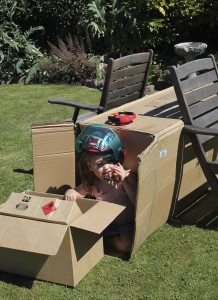Cardboard Boxes and Early Learning
When I was about five years old, the refrigerator in our kitchen stopped working. That avocado colored homage to 1970s kitsch had to be replaced. My parents loaded us up in the station wagon, and off we went to Sears for a new one.
I’ve always gotten excited about new gadgets: shiny, new, amazing! This time, though, the giddiness of a new refrigerator was surpassed by my enthusiasm for something else: the box in which it was delivered. There it was, standing tall in our living room, towering over everything else, nearly touching the ceiling fan. There it stayed for several weeks.
My parents allowed my brother and me to keep the box, and it became a gateway to new worlds and ways of playing. We moved inside it, bringing stuffed animals, books, and flashlights. We drew on its insides and imagined it to be a castle to be defended from invaders and a spaceship to take us to the moon.
 One day, one of us had the idea to take it outside, where we promptly took turns laying down inside and rolling it and us down the hill of our front yard before finally using it as a sled. Sledding down the hill was faster than rolling and allowed us to more easily control our stops when we neared the fence at the bottom of the hill.
One day, one of us had the idea to take it outside, where we promptly took turns laying down inside and rolling it and us down the hill of our front yard before finally using it as a sled. Sledding down the hill was faster than rolling and allowed us to more easily control our stops when we neared the fence at the bottom of the hill.
When I remember that refrigerator box, I remember barely playing with my toys. They were not needed; my imagination became my favorite toy. The box prompted more creative play than anything Fisher-Price or Hasbro ever sold.
Moving Smart shared a blog post called What Cardboard Boxes can Teach Kids in November 2013 where they describe six dimensions of learning related to cardboard boxes. In addition to prompting imagination, the idea of “asensory play” is introduced.
“The brown color suggests nothing in particular. The smooth sides infer little. The cube structure defines empty space. The subtle smell lacks distraction. The sound of the cardboard folding is muted and music-less. This very LACK of sensory inputs (or perhaps, more accurately said, the subtle nature of the sensory inputs) is an essential contrast to the more powerful and deliberate stimulation we traditionally think of when we talk about “sensory play.”
This relief from the sensory world may explain, in part, why kids find the confines of a cardboard box so appealing. And of course, its very neutrality is the blank-slate upon.”
The usefulness of cardboard boxes for children has been discussed and recognized by the media. One PreK teacher in Ohio went so far as to replace all the toys in his classroom with cardboard boxes with phenomenal success.
What experiences have you had using cardboard boxes in your classroom? Tell us about them in the comments.
Possible GELDS Connections:
PDM3.4b Demonstrates spatial awareness through play activities.
APL1.4a Takes initiative to learn new concepts and try new experiences. Initiates and completes new tasks by himself/herself.
APL1.4b Selects and carries out activities without adult prompting.
APL3.4a Engages in independent activities and continues tasks over a period of time.
APL3.4c Works cooperatively with others to successfully achieve a goal or accomplish a task.
APL4.4a Engages in elaborate and sustained imagined play, and can distinguish between real life and fantasy.
APL5.4c Demonstrates inventiveness, imagination and creativity to solve a problem.
APL5.4d Considers a variety of possible solutions and exhibits flexibility if an alternate approach is suggested by a peer or adult.
CD-CP2.4a Explains how to use objects in new situations.
CD-CP2.4b Uses observation and imitation to transfer knowledge to new experiences.
CD-CR4.4d Participates in dramatic play to express thoughts, feelings and creativity.
Leave a Reply